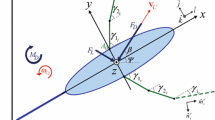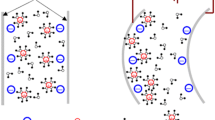Abstract
This paper addresses the design of a biomimetic fish robot actuated by piezoceramic actuators and the effect of artificial caudal fins on the fish robot’s performance. The limited bending displacement produced by a lightweight piezocomposite actuator was amplified and transformed into a large tail beat motion by means of a linkage system. Caudal fins that mimic the shape of a mackerel fin were fabricated for the purpose of examining the effect of caudal fin characteristics on thrust production at an operating frequency range. The thickness distribution of a real mackerel’s fin was measured and used to design artificial caudal fins. The thrust performance of the biomimetic fish robot propelled by fins of various thicknesses was examined in terms of the Strouhal number, the Froude number, the Reynolds number, and the power consumption. For the same fin area and aspect ratio, an artificial caudal fin with a distributed thickness shows the best forward speed and the least power consumption.
Similar content being viewed by others
References
Bandyopadhyay P R. Trends in biorobotic autonomous undersea vehicles. IEEE Journal of Oceanic Engineering, 2005, 30, 109–139.
Sfakiotakis M, Lane D M, Davies J B C. Review of fish swimming modes for aquatic locomotion. IEEE Journal of Oceanic Engineering, 1999, 24, 237–252.
Barrett D S, Triantafyllou M S, Yue D K P, Grosenbaugh M A, Wolfgang M J. Drag reduction in fish-like locomotion. Journal of Fluid Mechanics, 1999, 392, 183–212.
Fish F E, Lauder G V, Mittal R, Techet A H, Triantafyllou M S, Walker J A, Webb P W. Conceptual design for the construction of a biorobotic AUV based on biological hydrodynamics. Proceedings of the 13th International Symposium on Unmanned Untethered Submersible Technology, Durham, NH, USA, 2003.
Liu J, Hu H. A 3D simulator for autonomous robotic fish. International Journal of Automation and Computing, 2004, 1, 42–50.
Anderson J M, Kerrebrock P A. The vorticity control unmanned undersea vehicle (VCUUV): An autonomous robot tuna. Proceedings of the 11th International Symposium on Unmanned Untethered Submersible Technology, Durham, NH, USA, 1999, 63–70
Ayers J, Wilbur C, Olcott C. Lamprey robots. Proceedings of the International Symposium on Aqua Biomechanisms, Tokyo, Japan, 2000.
Guo S, Fukuda T, Asaka K. A new type of fish-like underwater microrobot. IEEE/ASME Transactions on Mechatronics, 2003, 8, 136–141.
Mossi K, Selby G V, Bryant R G. Thin-layer composite unimorph ferroelectric driver and sensor properties. Materials Letters, 1998, 35, 39–49.
Balakrishnan S, Niezrecki C. Investigation of THUNER actuators as underwater propulsors. Journal of Intelligent Material Systems and Structures, 2002, 13, 193–207.
Borgen M G, Washington G N, Kinzel G L. Design and evolution of a piezoelectrically actuated miniature swimming vehicle. IEEE/ASME Transactions on Mechatronics, 2003, 8, 66–76.
Wiguna T, Syaifuddin M, Park H C, Heo S. Mechanical design, fabrication and test of biomimetic fish robot using LIPCA as artificial muscle. Proceedings of SPIE 13th Annual Symposium on Smart Structures and Materials, San Diego, CA, USA, 2006, 617314–617342.
Yoon K J, Park K H, Lee S K, Goo N S, Park H C. Analytical design model for a piezo-composite unimorph actuator and its verification using lightweight piezo-composite actuators. Smart Materials and Structures, 2004, 13, 459–467.
MSC Software Corporation. User’s Guide Manual of MSC/NASTRAN, version 2005, MSC software, 2005.
Prentice Hall, Timoshenko S, Young D H. Element of Strength of Materials, 5th ed. D Van Nostrand Company, New York, 1968.
Author information
Authors and Affiliations
Corresponding author
Rights and permissions
About this article
Cite this article
Heo, S., Wiguna, T., Park, H.C. et al. Effect of an artificial caudal fin on the performance of a biomimetic fish robot propelled by piezoelectric actuators. J Bionic Eng 4, 151–158 (2007). https://doi.org/10.1016/S1672-6529(07)60027-4
Published:
Issue Date:
DOI: https://doi.org/10.1016/S1672-6529(07)60027-4




